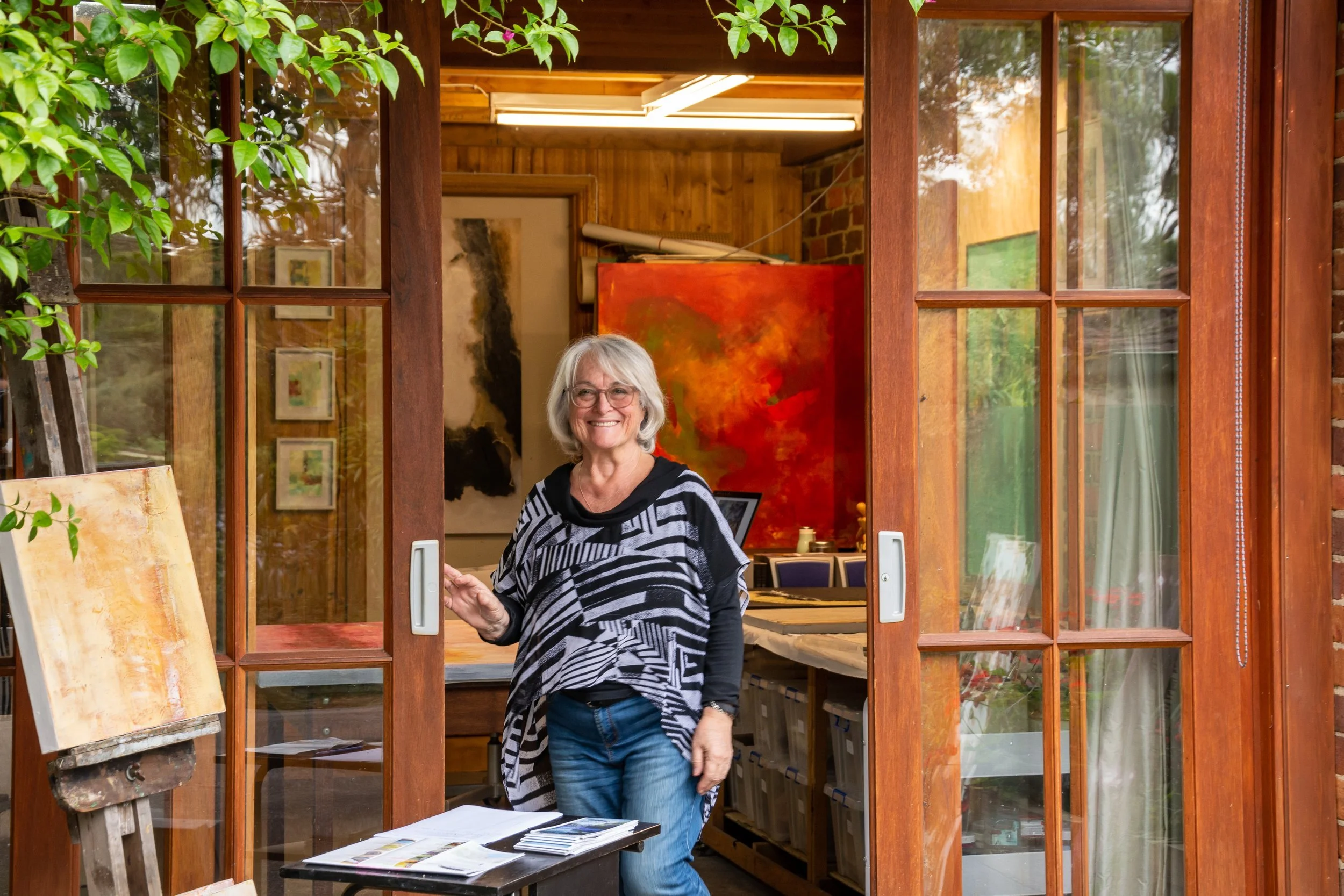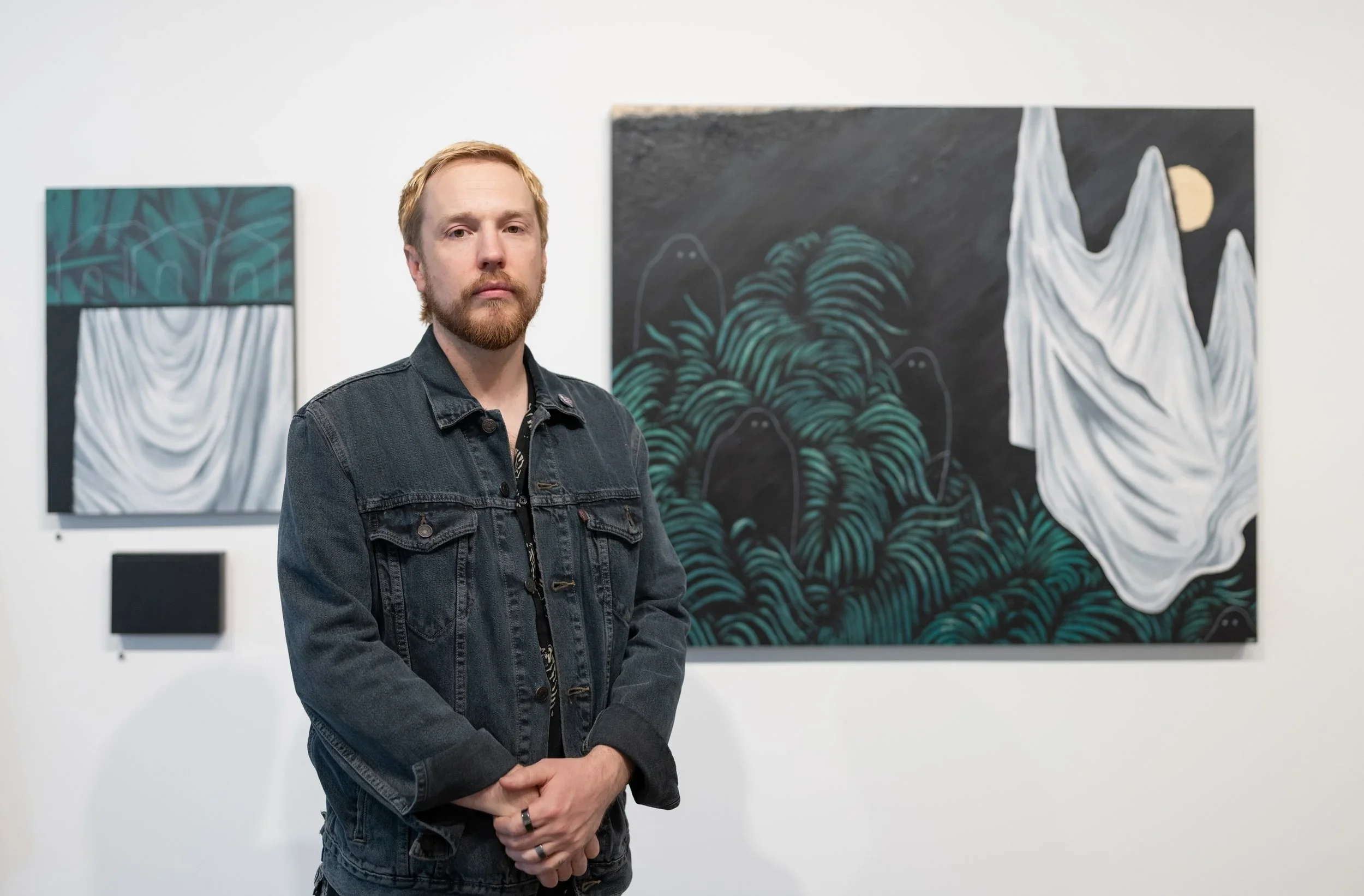10 Questions with Maria Fernandez
Maria Fernandez was born in Buenos Aires, Argentina, and has been based in Melbourne since 1986. She also lives in Barcelona half of the year, “following the sun” and being inspired by the beautiful colours of the Mediterranean Sea.
Fernandez works predominantly with the painting medium and also sometimes with photography. She is inspired by the diversity of textures and colours drawn from nature and by objects and materials that have been used, have aged, and have then been discarded. She is interested in the history embedded in these objects, in their texture of decay. Fernandez mainly paints abstract forms to reflect the environment that surrounds her, the elements that she remembers or, for some reason, have caught her attention in the past.
Fernandez’ technique is mainly based on building textures as well as layers of colour of different depths. She experiments with media and techniques to express herself with freedom and with no boundaries. She is inspired by American Abstract Expressionists, mainly Rothko and Pollock, as well as many of the Catalan maestros of modern times, Tapies, Miro, and Picasso.
Maria Fernandez - Portrait
ARTIST STATEMENT
Fernandez was born in Argentina and is now based in Australia and Spain. She keeps moving between the two countries following the sun, continuously getting inspired by the strong artistic cultures of the places she lives in or visits. The magnificent Mediterranean coast and the extreme Australian landscape are the main sources of inspiration. In addition, instinct and spontaneity are key factors that accompany her creative vision.
Maria’s technique is characterized by innovative and complex use of visual imagery, textures, color, and mark-making. She experiments with different media and techniques using acrylic, oil, cold wax, encaustic, collage and some unusual materials like bitumen and cement, to express herself with total freedom and without any boundaries.
Fernandez loves architecture and interior design, and her large-scale paintings are very suitable for homes and workspaces. She thinks that works of art should not only be appreciated once in a while in an art gallery or museum but also in our own homes where we can see and enjoy them every day.
Maria provides viewers with the lovely experience of finding shapes within shapes and images behind images to provide them with a safe, nurturing, emotional passage through the canvas.
Underground, mixed media on canvas, 120x60 cm, 2023 © Maria Fernandez
INTERVIEW
Let's start from the basics. How did you start getting interested in art? And what keeps you motivated?
Since I was little in Argentina, I had a very artistic mind and loved experimenting with paint and creating sculptures with found objects.
In Australia, during my career as a Computer Scientist, I developed a very analytical mind. But at a certain point, I felt the need to explore again my creative, artistic side, so I started taking painting lessons, and it all took off from there.
With painting, I discovered that art is a very powerful form of self-expression, to share thoughts, experiences, emotions, and feelings. It reflects who you are as an individual and what you enjoy without having to say anything. Art requires you to shake your mind and body freely. It is fun and brings you joy.
I've found that through abstract art, I can convey my feelings by using layers, colors, and shapes in a free and creative way, which I can't do with representational art. This keeps me motivated as I try to create a deep personal connection between the viewer and my artwork.
What do you wish you knew about contemporary art before you got started?
I wish I knew that sometimes contemporary art can be really hard, and you may struggle with one piece and have to be patient.
I wish I knew that inspiration comes while you work and not the other way around! In the words of Picasso, "Inspiration exists, but it has to find you working."
I wish I knew that patience is key and that consistent work leads to mastery. I didn't understand then, but I do now, that practice, no matter how small or for how long, can transform your creativity into something much greater if you just stick with it and keep doing it often and consistently.
I wish I knew that it's also okay to take a break and take some time for your creative juices to flow again. You have to create at your own pace; you may leave a piece for a while to come back later to look at it again with new eyes.
It's important to establish the right mindset, one that takes the pressure off having to produce a perfect, exhibition-ready piece.
Acqua, Acrylic on canvas, 92x92 cm, 2013 © Maria Fernandez
Badaloun, Acrylic on canvas, 120x120 cm, 2016 © Maria Fernandez
In your statement, you mention living between Australia and Spain, "following the sun." How important is this element for your art? And where else do you find inspiration?
Life experiences are a great source of inspiration for me as an artist. It is a way to connect with myself, my environment, and the people I'm trying to reach. Often people see these aspects in my paintings. I love it as it is a way to share my life events, and it means that I've been able to translate them onto a canvas.
All the places I have visited or lived in have left traces, and these are key elements of my art. I have a strong connection with the sea, beaches, trees, and foliage, so most of my work is inspired by these.
Can you tell us about the process of creating your work? What aspect of your work do you pay particular attention to?
I do not have an established set process. I always start with experimentation: a new technique, a new material, or something that has drawn my attention. I usually work on layers of elements and colors to develop a composition, and I try to slowly refine it until I get what I want.
Being playful is the most radical thing I do. I find that in order to successfully make an abstract artwork, I have to be open to the different possibilities and directions in which the work itself may take me. In doing so, I am allowing the process of doing the work to govern the outcome, trying not to be overly analytical and critical of what I am doing while doing it.
I give the analytical side of my brain a rest and try to access the instinctive, intuitive side. I try not to overthink what the final outcome might be and attempt to be fully present when I am painting.
I play music while I work to help distract me from any over-analytical thinking.
The physical action of making a piece that is larger than myself challenges me, but the rewards are great. I keep it simple in the first instance, using a limited palette, and then let intuition guide me.
I may develop several paintings at the same time and even in the same session, perhaps working on each for only a few minutes at a time before moving on to the next one. This can keep the process always fresh.
This period is all about process, method, and materials. I fully engage with the painting looking to define bold forms against line, texture, and tone. I try to always be responsive to the painting and where it's taking me, mindful of not overworking it.
To find new ideas for my paintings, I tend to experiment with different media, working with oil paint, acrylics, and cold and hot wax, including unusual materials like bitumen, sawdust, ash, or anything I find in nature. I like seeing what happens when I let myself play and experiment with different elements. I always get surprised by what I come up with!
There are many reasons why nature makes for such a great starting point when creating abstract paintings and conveying meaning. For one, nature is full of color. If I find myself stuck in a rut with a color palette, taking a walk outside is sure to give me some new ideas. Also, nature is always changing—which means that there's always something new to inspire me. Whether it's the first buds of spring or the colorful autumn leaves, nature provides endless opportunities for abstraction.
Bulldog, acrylic on canvas, 130x110 cm, 2020 © Maria Fernandez
Tell us more about your abstract painting. What does it represent for you? Do you have any specific theme you want to focus on?
Abstract art is very creative; as an artist, I can experiment and innovate with different techniques, materials, and concepts to produce original works.
I see myself as an abstract landscape artist. I get inspiration from places I live or visit. These show my art. I take a walk outside; I look for shapes, colors, and forms that catch my eye. Then, I see if I can incorporate these elements into my painting in a way that feels natural to me.
Do you have a role model that you've drawn inspiration from when creating your art?
I am inspired by modern masters, especially abstract expressionists like Mark Rothko, Gerard Richter, Franz Kline, Willem de Kooning, and others. My work is strongly influenced by them. I'm also inspired by the Catalan masters Antoni Tapies, Joan Miro, and Pablo Picasso.
Ethereal, acrylic on canvas, 180x150 cm, 2016 © Maria Fernandez
What are you working on now, and what are your plans for the future? Anything exciting you can tell us about?
I am now working with unusual materials like bitumen, sand, ash, and cement, mixing them with paint. All these materials allow me to obtain different textures and depths to create beautiful landscapes.
I'm planning two exhibitions this year and looking for a gallery that will represent me in Spain. I'm also excited about doing some collaborative work with other artists.
You already have quite a long career. How do you promote your work?
I have had solo and group exhibitions and participated in local open studio events in Australia and Spain. Also, my own website and social media are great ways to promote my art.
Cielo naranja, acrylic on canvas, 101x101 cm, 2016 © Maria Fernandez
De arena y mar, acrylic on canvas, 136x138 cm, 2015 © Maria Fernandez
What do you hope to accomplish this year, both in terms of career goals and personal life?
Perform exhibitions in Spain to gain more recognition in this country.
Expand my audience via social media.
Learn and master new techniques, experiment with more materials, and push the boundaries of my craft.
Explore abstract sculptures with clay and wood.
Collaborate with other artists.
Participate in Art events.
Finally, what is the biggest lesson you have learned so far from your artistic career?
Be patient and perseverant. To practice constantly, as the learning curve is endless and always exponential.
Do not be over-analytical. I believe that the best art comes from expressing yourself and following your intuition.
An artist goes from nothing, a mere piece of paper or canvas, to something, often a thing of beauty. We do this all by ourselves, over and over again. This task means that we are continually facing and contending with our own limits, so we need to overcome them and keep doing it.
Being creative is an invaluable part of maturing as a human being.























